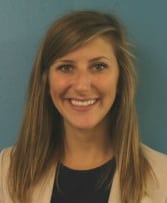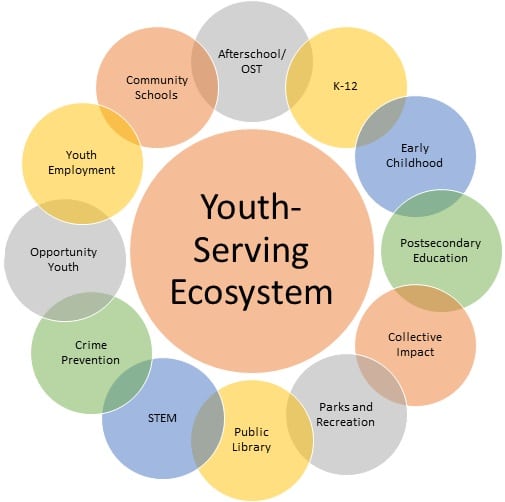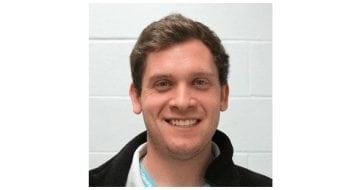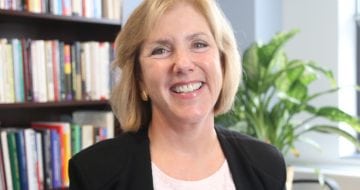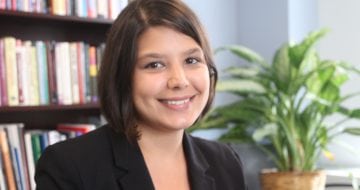Cities around the country are increasingly focused on building afterschool or out-of-school time (OST) systems. However, each community is unique in the challenges and opportunities that come with building and sustaining these systems. Over the past few years, AYPF has been examining the ways in which national research and best practices on OST systems align with the needs and contexts of different communities around the country. Upon examination, one thing is clear: relationships with K-12, youth employment, and other youth-serving systems are critical in building and sustaining an effective OST system.
Why build relationships with other systems?
Those of us working in education and youth development want all children to have the opportunity to be successful in school, work, and life. However, schools can’t bear the burden of doing this work alone. Additionally, in working with leaders in OST systems around the country, we’ve learned that while in-school (K-12) and out-of-school partnerships are instrumental, there are also opportunities for strategic partnerships and alignment with other systems that share common goals with OST, serve similar populations, or meet similar needs in the community.
The above graphic provides an example of the variety of local systems with which the OST field can potentially intersect, but is by no means an exhaustive list of potential partnership opportunities for OST systems. To be clear, we do not believe that every OST system should partner with each of these other systems, nor do we believe that every community’s “ecosystem” should look like the one pictured above. We do believe that cities or regions working on OST should thoughtfully consider the other systems that exist (or could exist) within the community, and carefully evaluate opportunities to work together as part of a greater continuum of youth services.
These various systems are unique and specialized in the sense that each one brings its own strengths to the table. For example, although OST can provide exceptional learning opportunities for younger learners, the work done within an early childhood system cannot and should not be replaced by the work of OST or other systems. We have learned, however, that these systems can be stronger together, mutually beneficial, and can have positive impacts on youth and the community. Whether the community goal centers around academic outcomes, employability, school attendance, youth engagement, social-emotional learning (SEL), or a host of other outcomes, cities and regions around the country are beginning to leverage these types of partnerships to support a more robust youth-serving ecosystem.
What might these relationships look like?
Below are examples of strategic alliances that cities have built with other community systems. Rather than coordination for coordination’s sake, these relationships are examples of OST intermediaries that have capitalized on the strengths of other systems to prepare young people for successful, fulfilling adult lives.
STEM in Austin, TX – Learn All the Time Network (LATT), the OST intermediary serving Central Texas, has been working in partnership with regional organizations and the Greater Austin STEM Ecosystem to find ways to scale effective science, technology, engineering and math related learning opportunities for all young people in the community by creating rich, hands-on learning environments in the OST time space. Since Austin is seen as a hub of technology and innovation, it is a community priority to equip the emerging generation of leaders with the skills and competencies necessary to sustain the momentum of the STEM-centered workforce.
Youth Employment in Chicago, IL – After School Matters (ASM) focuses on designing and delivering paid, project-based learning opportunities like internships and apprenticeships to allow older youth to develop critical professional skills and gain experience in the workforce. ASM works closely with employers and has an extensive network of public and private partners to reduce youth unemployment and provide opportunities for skill building within the community.
Opportunity Youth in Milwaukee, WI – Beyond the Bell Milwaukee (BTB) is working with partners to create a sense of community for older, disconnected youth that centers around engagement in education and the workforce. BTB identified youth unemployment and lack of opportunities for engagement as problems in the community, and are working together with leaders in the opportunity youth and youth employment sectors to find ways to provide the personalized supports needed for re-entry into the education and workforce systems with the ultimate goal of establishing a continuum of connection for Opportunity Youth.
Collective Impact in Louisville, KY – Louisville BLOCS, in partnership with the local collective impact initiative 55,000 Degrees, is working to increase the postsecondary attainment of Louisville youth by 2020. BLOCS is primarily focused on how OST can provide opportunities for young people to develop the 21st century (or non-academic) skills needed to succeed after high school, such as creativity and critical thinking. Leaders in Louisville identified the need for greater postsecondary attainment for the sake of both students and prospective employers, and as such this work is seen as both a youth development strategy and an economic development project.
Parks and Recreation in Grand Rapids, MI – Our Community’s Children (OCC) is working with various partners, including the City’s Parks and Recreation Department, toward a shared community goal to get young people involved in the outdoors. Given the community’s emphasis on the benefits of being in nature as well as the need for greater environmental consciousness, OCC and partners aim to strategically develop opportunities for young people to gain awareness of the environment while being immersed in the outdoors.
These partnerships may manifest in a variety of ways. Sometimes it’s as simple as two distinct intermediary organizations working together to achieve common goals, and in others we see the blending of knowledge, strategies, and funding between a host of systems and organizations. Regardless of the approach, the most effective partnerships are those that intentionally align systems in a way that is responsive to the needs and the context of the community. Our work in cities and regions across the country has taught us many things, but most importantly that we can work better when we work together.
Carinne Deeds is a Policy Associate at the American Youth Policy Forum.


